Contents
-
Current degree day (DD) accumulations
- Current bud stages
-
Upcoming meetings
The way I see it
- 2010 New England Tree Fruit Management Guide Available
- NEWA disease and insect models
- Winter moth a problem for some?
- Insecticide product registration update
- Useful links
Current (through April 5) degree day
(DD) Accumulations
Location: UMass Cold Spring Orchard (CSO), Belchertown, MA
Base 43: 164
Base 50: 76
Significant upcoming orchard events based on degree days (Base 43):
Green fruitworm flight peak: 100-210
Spotted tentiform leafminer 1st catch: 111-197
Oriental fruit moth 1st catch: 221-325
McIntosh at tight cluster: 211-253
Current bud stages
| Location | Mcintosh apple -- half-inch green + | Gold Bosc pear -- bud burst | PF-14 Jersey peach -- early bud burst | Ebony (Pearl) cherry -- swollen bud + |
| Belchertown UMass CSO (04/05/10) |
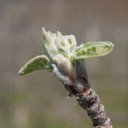 |
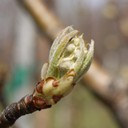 |
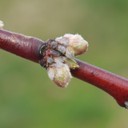 |
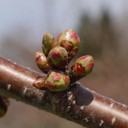 |
Upcoming meetings
April 20, 21, 22 2010: Tree fruit twilight meetings
Tuesday, April 20 -- UMass Cold Spring Orchard, 391 Sabin St., Belchertown, MA
(413) 323-6647Wednesday, April 21 -- Macks Apples of Moose Hill Orchards, 230 Mammoth Rd., Londonderrry, NH (603) 434-7619 (joint meeting with New Hamsphire Fruit Growers' Association and UNH Extension; note meeting starts at 5 PM)
Thursday, April 22 -- Ledge Ends Produce at the historic Briggs Boesch Farm, 830 South Rd., East Greenwich, RI (401) 884-5118 (joint meeting with Rhode Island Fruit Growers' Association)
Tree fruit twilight meetings start promptly at 5:30 PM. (Except April 21 meeting in New Hampshire which starts at 5 PM.) Pesticide recertification credit will be offered but you must be there at start of meeting to receive credit. There will be a $25 meeting admission charged at the door. ($20 for Massachusetts Fruit Growers' Association FULL members.) For more information, call Jon Clements: 413-478-7219.
Wednesday, April 21 -- Special Tree Fruit Growers' Demonstration: Using a Sprayer Patternator for Calibrating and Orchard Sprayer. 1 to 4 PM. Macks Apples of Moose Hill Orchards, 230 Mammoth Rd., Londonderrry, NH (603) 434-7619. More information.
The way I see it
Spring has sprung with a vengeance but I don't need to tell you that. Of primary concern right now should be making sure you are covered up with fungicide BEFORE the next major wetting period for apple scab AND if stone fruit (peach, cherry, plum, apricot) is in bloom, making sure they receive an appropriate fungicide spray for brown rot. Some additional observations on apple scab management as relayed by Dan Cooley:
- it's too late to apply fungicide with kickback IF you had green tissue, a high-inoculum orchard last year and a scab infection period during the last major wetting event (03/29 to 04/01). You may have already been infected but ascopsore maturity was very low (1-2%) so there was pretty minimal risk.
- that being said, consider the next significant wetting event to be a major scab infection risk with apple buds at tight-cluster or beyond. We will be entering the accelerated phase of risk. So, use full rates of protectant fungicide (mancozeb fungicide or Captan) or tank-mix half-rates of mancozeb with Captan, or mancozeb plus Flint or Sovran if using oil to make sure you are fully covered up with protectant fungicide.
Note that this will likely be your LAST ISSUE OF HEALTHY FRUIT for 2010 unless you renew your subscription using the web page here (you can pay by credit card) or filling out and sending in the enclosed form with your information and $$ remittance. Any questions about the status of your subscription, let us know.
J. Clements
2010 New England Tree Fruit Management Guide available
As a reminder, the 2010 New England Tree Fruit Management Guide is available for purchase here:
http://www.umass.edu/fruitadvisor/2010/2010netfmg.html
NEWA disease and insect models
I hope you will check out the NEWA apple insect and disease models for a site close to you. In a nutshell, they collect meteorogical data from 23 airport weather stations around Massachusetts and compute pest management recommendaitons based on the current (presumed) status of the insect or diseas pest. These models and recommendations are updated daily and include for INSECT: spotted tentiform leafminer, Oriental fruit moth, codling moth, plum curculio, oblique-banded leafroller, and apple maggot. For DISEASE: apple scab and fire blight. (The fire blight output being very urgent and useful in determining if strep sprays are needed as we approach and are in apple bloom.) For example, below is the current output for apple scab and Oriental fruit moth from the closest station to the UMass Orchard in Belchertown. Note that models and weather data such as these are not the absolute truth and are but one useful tool for helping make orchard management decisions. For example, looking at the Apple Scab Summary below, the Ascospore Maturity does not increment during the 5-day forecast yet one would expect it too given the temperature forecast.
J. Clements
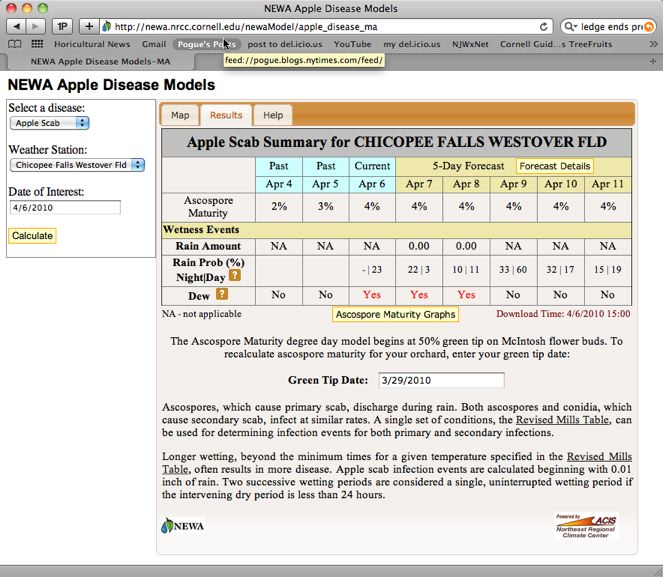

Winter moth a problem for some?
The subject of winter moth has come up a lot this spring as apparently there was a significant adult (male) flight early last winter. It's not on my particular radar screen as it does not venture much farther than 25 miles (if that much) from the coastline. But, if you have a history of winter moth inhabiting your apple orchard (or blueberries or surrounding woodland/shade tree edge) you are advised to treat for it now. It can do significant damage to fruit buds in short order. Sonia Schloemannand Bob Childs have put together a nice fact sheet on winter moth in blueberry for reference: Control of Winter Moth Damage in New England Blueberries. For apple most any registered insecticide or combination applied pre-pink will be effective. It is best to apply before the winter moth worms get too far into the buds where they are no longer exposed to insecticides. Up in Nova Scotia, where they have been dealing with winter moth for some time, and up to 50% of the orchards are treated for winter moth annually, "pre-bloom sprays of Dipel plus miniscule amounts of a pyrethroid have worked very well" according to Larry Luts of the Scotian Gold Cooperative.
Insecticide Product Registration Update
Art Agnello, Entomology, Geneva. Reprinted from Scaffolds Fruit Journal, March 22, 2010.
Label Changes
• The use of Guthion/azinphosmethyl products this year continues to change slightly from its previous rates, in accordance with the scheduled phase-out guidelines previously established by EPA. In both apples and pears, a total of 4 lb formulated product/A is allowed in 2010 — a reduction from 2009 in apples, but the same as last year for pears. This will change to 3 lb/A for both crops in 2011–2012, before being completely phased out. In cherries, it’s 1.5 lb/A for 2010–2012. Recall that there is a 60–ft buffer required from permanent bodies of water and occupied buildings, and a PHI in Pick-Your-Own operations scaled from 33–44 days, according to use rate. Read your labels carefully. These products had been previously excluded from use on peaches, nectarines, plums, prunes, and apricots.
• Warrior (1EC), EPA Reg. No: 100-1112, has been phased out. There may be some still in spray sheds and dealers’ hands that can be used up, but from this point on, any Warrior shipped to dealers will be Warrior II (2.08EC), EPA Reg. No: 100- 1295.
New Labels
• Centaur (Nichino America) insecticide; active ingredient: buprofezin, EPA Reg. No: 71711- 21. This product is an insect growth regulator registered in pome and stone fruits for the control of San Jose scale, mealybugs, leafhoppers and pear psylla.
• Adament (Bayer) fungicide, EPA Reg. No: 264-1052. This is a pre-mix product containing the strobilurin trifloxystrobin (the a.i. in Flint) and the SI tebuconazole (the a.i. in Elite); registered in pome and stone fruits.
• Isomate-PTB Dual (Pacific Biocontrol/CBC America) pheromone, EPA Reg. No: 53575-34. This polyethylene “rope” or “tie” dispenser is for- mulated for mating disruption of both greater and lesser peachtree borer in stone fruits; it replaces the Isomate-LPTB product.
• Altacor (Dupont) insecticide; active ingredient: chlorantraniliprole/ Rynaxypyr, EPA Reg. No: 352-730. This product belongs to a new chemical class, the anthranilic diamides. Altacor is labeled for the control of a range of insect pests in pome and stone fruits, including codling moth, oriental fruit moth, and obliquebanded leafroller.
• Voliam Xpress (Syngenta) insecticide; active ingredients: lambda-cyhalothrin, chlorantranili- prole; EPA Reg. No: 100-1320. A pre-mix of the a.i. of Altacor plus the a.i. of Warrior, registered in pome and stone fruits for a wide range of pests.
• [Comment by Jon Clements: Toursimo (Nichino America)also has a fit where Altacor or Voliam Xpress might be used. It is a combination of buprofezin (Centaur) and flubendiamide which is similar to the a.i. of Altacor. Hence, Tourismo is indicated for control ofall worms where scale or potato leafhopper are also of concern.
• Movento* (Bayer) insecticide; active ingredient: spirotetramat, EPA Reg. No: 264-1050. Movento is a tetramic acid registered for the control of a number of indirect pests in pome fruits and stone fruits, primarily aphids (including woolly apple aphid), mealybugs, pear psylla, and San Jose scale. (*see note below on current registration status)
• Portal (Nichino America) acaricide, insecticide; active ingredient: fenpyroximate, EPA Reg. No: 71711-19. Portal is a phenoxypyrazole acaricide and insecticide labeled for use in apples and pears to control European red mite, twospotted spider mite, pear rust mite, leafhoppers, mealybugs and pear psylla.
• Rage (FMC) herbicide, EPA Reg. No: 279- 3307. This product is a pre-mix of the active ingredients glyphosate (a.i. of Roundup) and carfentrazone (a.i. of Aim).
The Movento Situation (so far)
• Vintage (Gowan) fungicide, EPA Reg. No: 10163-275, is the new name for fenarimol, previously sold as Rubigan, which it replaces; registered in apples, pears and cherries.
The Lorsban Situation
Keeping current with Lorsban product labels continues to be a challenge. Last year (Issue No. 5, April 20), I printed a table summarizing the use guidelines for each of the three Lorsban products (Lorsban 4E, Lorsban Advanced, and Lorsban 75WG). Any of those products purchased last year that are still in growers’ hands may continue to be used as per their respective labels. However, Lorsban 75WG purchased this year has a new label that 1) eliminates the petal fall use in apples, and 2) eliminates the use of more than 1 application per season. Therefore, unless you are using 2009 Lorsban 75WG, it is now prohibited to apply ANY chlorpyrifos product in apples more than ONCE per season, whether it be as a pre-bloom foliar spray or as a pre- or post-bloom trunk spray. Read the label carefully.
The Movento Situation (so far)
Early in 2009, environmental groups brought a lawsuit against EPA in the Southern District of New York challenging EPA’s decision to register spirotetramat, the active ingredient in Movento and Ultor brand insecticides. The lawsuit sought to invalidate the registrations of Movento and Ultor, based in part on the procedure EPA followed in processing the registration. Specifically, EPA did not publish a notice in the Federal Register when the application for registration was submitted, announcing the application and soliciting public comment on it. Movento received a NY registration in August; however, on December 23, 2009, the court concluded that because EPA failed to publish a notice of its receipt of the application for registration, the EPA’s registrations of Movento and Ultor would be vacated.
After several rounds of court motions and rulings, the EPA issued an Interim Cancellation Order for Movento and Ultor on March 12, stating that “use of product in the possession of the applicators is permitted provided such use is consistent with the previously approved labeling for the products.” Growers can continue to use material they have purchased that is in their possession. However, un- til the EPA publishes a final order either continuing or modifying the registration situation, it isn’t pos- sible to purchase any additional Movento or Ultor. Stay tuned.
(Note: this just in from Bayer: Today (April 5, 2010), the EPA issued the Final Cancellation Order for Movento and Ultor whichstates that it is legal for the distribution channel to sell and distribute Movento and Ultor which is currently in their possession. This order supersedes EPA’s Interim Cancellation Order issued on March 12, 2010. Additionally, the order reaffirms that growers can continue to use Movento and Ultor according to the previously approved labeling. A copy of EPA's final cancellation order can be found at http://www.epa.gov/opprd001/factsheets/spirotetramat-final-cancl-order.pdf)
Useful links
UMass Fruit Advisor http://www.umass.edu/fruitadvisor/
UMass Cold Spring Orchard Weather Data http://www.umass.edu/fruitadvisor/hrcweather/index.html
Scaffolds Fruit Journal http://www.nysaes.cornell.edu/ent/scafolds/
NEWA Apple Disease Models-MA http://newa.nrcc.cornell.edu/newaModel/apple_disease_ma
NEWA Apple Insect Models-MA http://newa.nrcc.cornell.edu/newaModel/apple_pest_ma
JMCEXTMAN Blog http://jmcextman.blogspot.com/
Follow me on Twitter http://twitter.com/jmcextman and Facebook http://www.facebook.com/jmcextman
